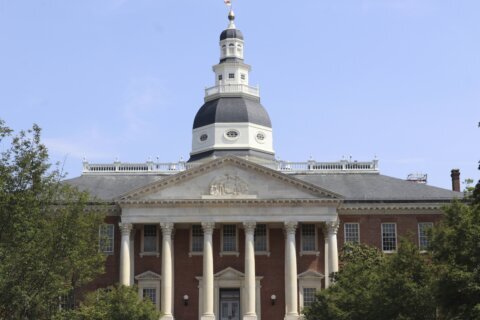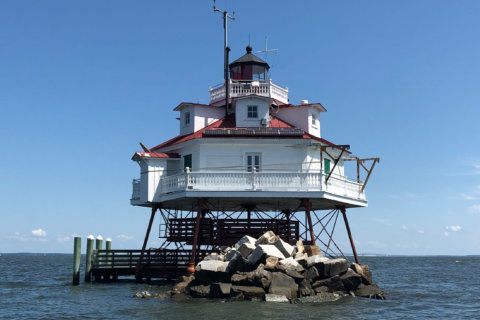This article was republished with permission from WTOP’s news partners at Maryland Matters. Sign up for Maryland Matters’ free email subscription today.
This content was republished with permission from WTOP’s news partners at Maryland Matters. Sign up for Maryland Matters’ free email subscription today.
It’s no secret that climate change has already had a devastating impact on Maryland’s coastal communities. In a state with more than 3,000 miles of shoreline — and where 72% of the population lives or works along the coast — the risk level for even more damage is always increasing.
So how is Maryland doing when it comes to confronting the rising temperatures, stronger storms and increased flooding already being experienced due to climate change?
The University of Maryland Center for Environmental Science (UMCES) has collaborated with the Adaptation and Resiliency Work Group of the Maryland Commission on Climate Change and the Department of Natural Resources on a first-of-its-kind report card that gives a snapshot of the current adaptation status in Maryland’s coastal counties and establishes a framework for measuring future progress.
Maryland Environment Secretary Ben Grumbles, who co-chairs the state climate commission, called the Maryland Coastal Adaptation Report Card “groundbreaking” and “one of the most important steps we can take to track coastal resilience and accelerate climate progress in Maryland.”
“By thinking globally and measuring locally, we are driven to grow greener and smarter and that means slashing greenhouse gases and disaster costs in our communities,” he said.
The report card, which was released Friday, gives the state an overall grade of B-minus. However, the review outlined several shortfalls that could lead to more significant damage.
“Some indicators that were measured already meet, or are close to meeting, current adaptation goals, while others require significant investment to achieve adaptation goals,” the scientists and researchers who compiled the report wrote.
The report card comes as the General Assembly prepares once again to consider aggressive legislation to address climate change in the state. The Senate and House could not agree on the best approach to the legislation in the final hours of last year’s legislative session.
The new adaptation report card scored progress across Maryland’s coastal jurisdictions through 15 indicators divided in four categories — ecosystem, flooding, planning, and socioeconomic.
The ecosystem and planning categories scored an A and a B-plus, respectively. State and local governments have been particularly good about maintaining wetland acreage, the report found, and in using dredged materials for restoration. Populations in floodplain areas have also been reduced, decreasing the potential threat of coastal emergencies.
But the report warned that more must be done to improve data collection and what’s known among climate scientists as “flood risk visualizations” — maps that show different scenarios as climate projections change.
Progress toward meeting flooding and socioeconomic adaptation goals didn’t score as highly in the new survey, with both categories getting a C grade. Many indicators in these categories, such as flood insurance, miss adaptation targets and need to be improved, the researchers suggested.
“The most urgent challenges are the location of critical facilities that must remain operational in emergencies in flood hazard areas and the need to adapt certain previously flooded properties to withstand future climate events,” the report said.
Katie May Laumann, who led the development of the survey at UMCES’ Integration and Application Network, said finding adequate data was the biggest challenge in assembling the report card.
“Data gaps also present challenges to managers planning for adaptation,” she said. “Filling these gaps is important to inform planning and management decisions to improve Maryland’s adaptation status.”
The Hogan administration was clearly pleased with the overall progress outlined in the report.
“Maryland continues to be a leader in adaptation,” said Natural Resources Secretary Jeannie Haddaway-Riccio.
And the UMCES released supportive quotes from two leading Democrats who regularly work the climate issue — U.S. Sen. Benjamin L. Cardin and Del. Dana M. Stein (D-Baltimore County), vice chair of the House Environment and Transportation Committee in Annapolis — praising the adaptation report card as a valuable tool for providing information and setting policy priorities.
One leading environmental group took a more nuanced view of the report card’s conclusions.
“This report represents an important first step toward helping citizens and government leaders understand the significant risks we face from climate change in Maryland,” said Doug Myers, senior Maryland scientist for the Chesapeake Bay Foundation. “Establishing indicators, collecting data about them, and evaluating them honestly is necessary as Maryland works to adapt its thousands of miles of coastline to increasing sea levels and stronger storms.”
But Myers fretted about the dangers that climate change poses to public utilities and emergency services, especially in high-risk areas, and said recommendations in the report for making improvements aren’t always backed up by adequate funding or coherent plans to implement them.
“Even in the best-case scenario, in which greenhouse gas emissions are significantly reduced, sea levels in the Maryland region are predicted to rise 3 feet by 2100 — which would result in losses of coastal properties statewide,” Myers said. “Given this, we must act now by preserving forests, expanding wetlands, planting trees, and investing in green infrastructure such as rain gardens, permeable pavement, and green roofs to protect residents long-term.”







